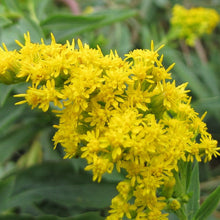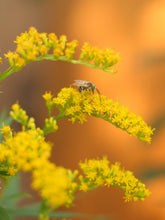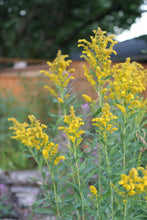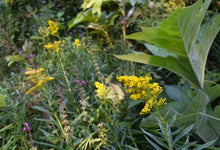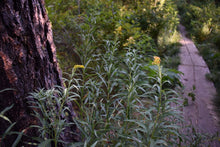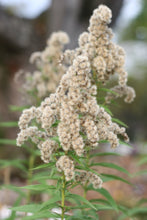
Solidago canadensis (aka Solidago lepida and Solidago elongata)
Goldenrod is a notably long-lived magnet for pollinators, beneficial insects and birds. Its rhizomatous clumps of lance-leaved vegetation can grow up to five feet high and last for decades. By mid to late summer, the stem tips droop with showy golden racemes that are a highly desired late season pollen source for bees, butterflies and hummingbirds. By fall, flowers beget seeds that are eaten by a number of small mammals and birds including American goldfinch, sparrows, towhees, pine siskins, and dark-eyed juncos.
- Plant type/canopy layer: deciduous, perennial, herbaceous plant
- Size at maturity: 3-5’ tall, clumps spread laterally by rhizomes
- Light requirements: full sun to part shade
- Moisture requirements: dry to moist soil
- Bloom time: July - October (August - Sept in the Portland Metro area)
- Growth rate/ease: fast growing, very easy to grow
- Wildlife support: flowers attract and provide nectar for hummingbirds, adult butterflies, bees and other insect pollinators; seeds are eaten by many birds and particularly adored by goldfinches; overall plant attracts and supports beneficial and other pest eating insects and is a caterpillar host plant and larval food source
- Native habitat/range: common in open woods, meadows, dunes, riverbanks, and roadsides, from sea level to 2250m, in all ecoregions of Oregon, California, and Washington. Portland Plant List - yes.
- Special features & uses: important late season pollinator plant; attracts hummingbirds; landscape uses include meadowscapes, pollinator gardens and woodland garden edges, erosion control and habitat hedgerows
Gardening with Goldenrod: Goldenrod is equal parts attractive and aggressive - and can be especially thuggish when babied with rich garden soils and supplemental moisture. But if you have the space, don’t hesitate to plant this important pollinator plant. Planting in tougher, exposed areas that don’t get any extra love will help keep it in check. Due to its tall stature and its desire to cover a rather large area, it can work beautifully interspersed in the middle and/or background of large meadowscapes, fields, exposed slopes and other challenging open areas you’re trying to colonize with native plants.
Photo Credit 1: "Canadian Goldenrod. (Solidago canadensis)" by Phil Sellens is licensed under CC BY 2.0
Photo Credits 2, 3, 6: Karli Del Biondo, Beetles and Bees
Photo Credit 4 & 5: Nikkie West, Sparrowhawk Native Plants






